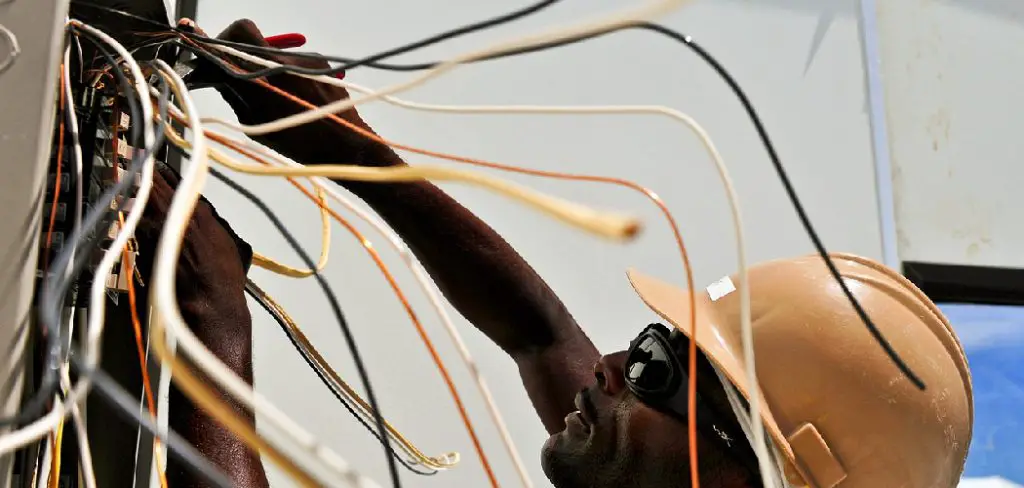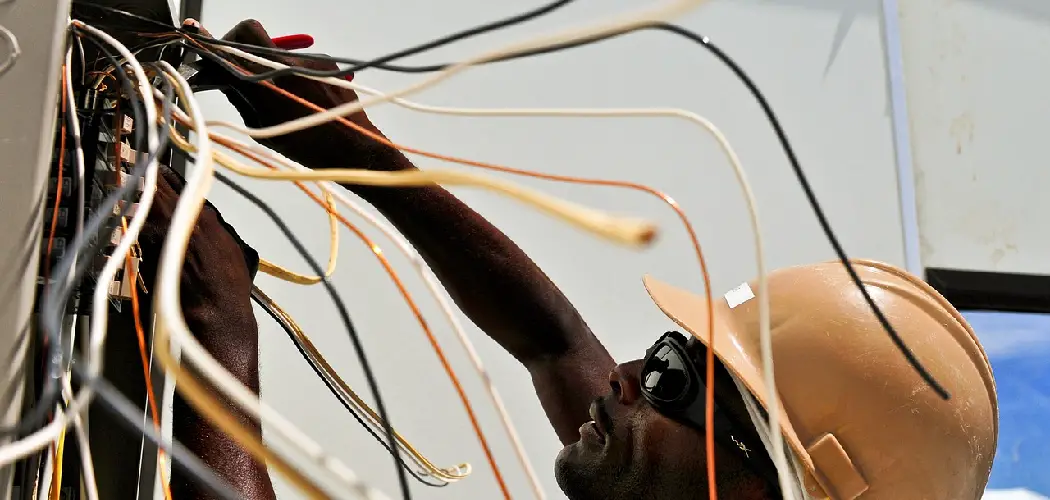Tracing electrical wires to the breaker requires turning off the power supply and using a circuit tester. If you’re planning an electrical project at home or need to fix an electrical issue, tracing wires to the breaker is an essential task.
Understanding the circuit diagram and labeling the wires will help to avoid making mistakes and ensure that the job is completed correctly. However, tracing wires can be daunting if you’re not an electrician or familiar with electrical systems. This article will provide some simple steps to follow to trace the wires to their source and identify the corresponding circuit breaker.
We’ll also explain how to stay safe by turning off the power and using a circuit tester. So, let’s get started.

Tools Needed For Tracing Wires To The Breaker
Tracing electrical wires to the breaker can be a daunting task, especially if you’re not experienced in electrical work. However, with the right tools, anyone can identify the correct breaker for a specific circuit. We’ll discuss the essential tools required for tracing wires to the breaker.
List Of Essential Tools Required For The Process
Here’s a list of the essential tools needed for tracing electrical wires to the breaker:
- Voltage tester
- Circuit tracer or probe
- Screwdriver set
- Wire strippers
- Pliers
- Electrical tape
- Label maker or tape
Detailed Explanation Of Each Tool And Its Importance
Let’s dive into each tool in a little more detail and find out why it’s so necessary for the process.
- Voltage tester: This tool is essential for checking the electrical current in the circuit. It helps determine if the wires are live or not and is crucial in avoiding electrical shock.
- Circuit tracer or probe: This tool helps to identify the path of a circuit and the location of the breaker. Circuit tracers can detect live circuits behind walls and other concealed places.
- Screwdriver set: A set of screwdrivers with a variety of sizes and shapes will help you access different parts of the panel. A screwdriver set will give you the flexibility to both tighten and loosen screws when you’re examining the wires.
- Wire strippers: An essential tool for cutting insulation from wires, wire strippers help create a clean connection. Electrical tape is frequently used to re-cover bare wires and will be needed for safety purposes.
- Pliers: Pliers aid in twisting and cutting wires and are helpful when making connections. Pliers can also be useful when removing hard-to-reach wires from the breaker.
- Electrical tape: Electrical tape helps protect splices, wire connections, and other electrical surfaces, preventing accidental contact.
- Label maker or tape: A label maker or tape will be used to mark wires and components, making it easier to identify them when you need to work on the circuit again. This is critical for safety and convenience purposes.
By using these essential tools, you can safely trace electrical wires to the breaker. Always remember to ensure that your work environment is safe and free of any potential hazards before beginning any electrical work.
Step-By-Step Guide To Tracing Wires To The Breaker
Detailed Explanation Of The Process Of Tracing Wires To The Breaker
Tracing electrical wires can seem daunting, especially if you’re not familiar with electrical systems. However, by following a step-by-step process, you can successfully trace wires to the breaker and identify the source of any electrical issues. Here’s how to do it:
- Turn off your power supply – before tracing any wires, make sure that the power is turned off to avoid any safety hazards.
- Identify the electrical panel – locate the electrical panel or breaker box in your home. It’s usually found in the basement, garage or utility room.
- Find the wire you want to trace – identify the wire you want to trace. Electrical wires are typically color-coded and labeled according to their function, such as lighting or heating.
- Remove the panel’s cover – to get started, remove the cover of your electrical panel. You’ll need a screwdriver to take off the cover.
- Locate the circuit breaker – look for the circuit breaker that corresponds to the wire you’re tracing. Circuit breakers are usually labeled with the room or appliance they control.
- Trace the wire – follow the wire from its endpoint to the circuit breaker. Use your pen or marker to mark the wire so you can easily identify it.
Tips And Tricks For Successful Wire Tracing
Tracing electrical wires can be tricky, but with these tips and tricks, you’ll get the job done quickly and safely.
- Use a voltage tester – use a voltage tester to ensure that there’s no electricity flowing through the wire before you start tracing it.
- Label wires and breakers – as you trace wires, make sure to label them clearly and mark the corresponding circuit breaker on the panel. This will help you identify them in the future.
- Work in pairs – tracing wires can be a two-person job, particularly if you’re working on a complex circuit or in an unfamiliar setting.
- Consult an expert – if you’re unsure or uncomfortable with the process of tracing wires, seek the help of a professional electrician. They can help you locate and identify wires quickly and safely.
Importance Of Safety Precautions
Tracing electrical wires can be hazardous, and it’s crucial to adhere to safety precautions to avoid accidents. Here are some safety tips to keep in mind:
- Turn off power – before you start tracing wires, shut off the power to the circuit. This will ensure that no electricity is flowing through the wires.
- Wear proper gear – when working with electrical systems, it’s important to wear protective gear such as gloves, eyewear, and footwear with rubber soles.
- Use the right tools – use only tools that are insulated and designed for electrical work. Never use tools that are damaged or past their expiration date.
- Work methodically – tracing wires can be complex, so make sure to work methodically and take breaks as needed to avoid mistakes or accidents.
- Call a professional – if you’re unsure about how to trace wires or feel uncomfortable with the process, call a professional electrician for help. It’s never worth risking your safety or the safety of others for a diy project.
By following the step-by-step guide, utilizing tips and tricks for success, and adhering to safety precautions, you can responsibly trace electrical wires to the breaker and keep your home safe and functional.
Common Mistakes To Avoid When Tracing Wires To The Breaker
Tracing electrical wires to the breaker is a critical task, especially when it comes to troubleshooting electrical circuits. However, this process can be tricky, even for experienced electricians. One wrong move can lead to costly damages or, even worse, electrical hazards.
In this section, we’ll explore the most common mistakes made during this process, and how you can avoid them to keep your electrical system safe and functional.
A List Of Common Mistakes Made During The Wire Tracing Process
Here are the top mistakes electricians tend to make when tracing electrical wires to the breaker:
- Not turning off the power: Tracing electrical wires while the power is still on is a significant safety hazard that can result in electrocution, short circuits, and even fires.
- Trying to trace wires visually: Most electrical wires are behind walls or run through various electrical components, making it impossible to trace them visually.
- Not using the right tools: Using incorrect tools can lead to injuries, damages to the wires or electrical components, and inaccurate tracing.
- Not testing the wires: Electricians sometimes assume that they have found the right wire without double-checking it using a circuit tester, leading to incorrect tracing and misidentifying wires.
- Misinterpreting wire colors: Wire color-codes aren’t universal, and they can vary across different manufacturers, installers, and electricians, which can cause confusion and misidentification.
How To Avoid These Mistakes
Here are some ways to avoid these mistakes when tracing the electrical wires:
- Turning off the power: Always turn off the power to the electrical circuit that you’re working on before tracing wires. You can do this by switching off the main breaker or the circuit breaker you’re dealing with.
- Using the right tools: Use the correct circuit testers, wire tracing devices, or multimeters that match the wire’s voltage and frequency.
- Testing the wires: Before tracing, test the circuit using a circuit tester to make sure that the wires are not live.
- Labeling wires: Label wires as you trace them so that you don’t misidentify them later. Labeling also helps when you need to reconnect them.
- Consulting electrical diagrams: Electrical diagrams outline the wire routes, so use them to determine which wires connect where.
- Using a tone and probe kit: For wires that are hidden behind walls or components, you can use a tone and probe kit that can trace the wire’s path by detecting the tone it emits.
The Potential Consequences If The Mistakes Are Not Avoided
The consequences of failing to avoid these common mistakes when tracing electrical wires to the breaker can be dire. Some of the potential consequences include:
- Electrical fires and explosions: If you tamper with live wires or mishandle them, it can cause short circuits or arcing that leads to electrical fires and explosions.
- Injuries and deaths: Electrocution, electric shocks, and burns can occur when you come into contact with live wires.
- Property damage: Damaged wires or electrical components can interrupt a circuit, damage equipment, and cause costly repairs.
- Time-consuming and costly repairs: Misidentifying wires and tracing them incorrectly can lead to hours or days of troubleshooting and costly repairs, not to mention the frustration that results from failing to locate the problem.
Tracing electrical wires to the breaker can be a challenging task, but with the right tools, knowledge, and precautions, you can do it safely and efficiently. By avoiding the common mistakes outlined above, you can save yourself from hazards, property damage, and costly repairs.
Benefits Of Tracing Wires To The Breaker
Have you ever experienced electrical issues in your home, and you have no idea where to start? Tracing electrical wires to the breaker is an important skill that every homeowner should possess. Benefits of this skill can range from saving time and money to preventing a potentially dangerous situation.
Let’s explore these benefits in more detail.
Explanation Of The Benefits Of Successfully Tracing Wires To The Breaker
Tracing electrical wires is a crucial step in identifying the source of any electric problem in your home. Below are just a few reasons why learning how to trace electrical wires to the breaker can be beneficial in the long run:
- Prevent safety hazards: Tracing electrical wires can help you identify and repair possible safety hazards, such as frayed wires or overloaded circuits, before they cause injury or fire.
- Save money: Finding and fixing electrical issues can be costly, especially if you have to call in a professional. Knowing how to trace electrical wires to the breaker can help you troubleshoot and identify issues without calling in a pro, thus saving you money.
- Save time: Tracing wires can lead to quick identification of the source of an electrical issue, so you don’t have to spend hours guessing or waiting for a repairman. By fixing issues promptly, you can get back to your regular schedule without major interruptions.
- Knowledge: Knowing how to trace electrical wires to the breaker can give you a better understanding of your home’s electrical system, so you can identify potential problems quickly in the future. This knowledge can save you time and money in identifying future electrical issues.
Real-Life Examples Of How These Benefits Have Helped Homeowners
Not only are these benefits of tracing wires to the breaker important in theory, but they have also been demonstrated in practical situations. Here are a few real-life examples of how homeowners have benefited from knowing how to trace wires to the breaker:
- A homeowner noticed that their refrigerator was not getting any power, and they had no clue where the issue was coming from. Instead of calling an electrician, they traced the wire from the refrigerator back to the breaker and identified that the circuit had tripped. They reset the circuit and saved themselves the cost of an unnecessary service call.
- Another homeowner noticed that their lamps in the living room flickered on and off during a storm. They traced the wires and found a damaged circuit breaker. They replaced the breaker within a few minutes, fixing the problem and preventing a potential electrical fire.
- One homeowner had a circuit breaker that kept tripping. They isolated the problem to a particular room in the house and later traced the fault to a damaged wire. By fixing the wire themselves, they saved a considerable amount of money on an electrician’s fee.
Learning how to trace electrical wires to the breaker can be beneficial in multiple ways. It not only gives you peace of mind by preventing potential safety hazards, saving money and time, but it also provides valuable knowledge that you can use to maintain your home’s electrical system for years to come.
Frequently Asked Questions For How To Trace Electrical Wires To The Breaker
How Do You Locate A Breaker For An Outlet?
Locate the outlet. Plug in a device that is easy to identify when it turns on, such as a lamp. Turn off all circuit breakers so none are generating electricity. Turn on each breaker one at a time until the device plugged in turns on.
The breaker for that outlet has been found.
How Do You Trace A Wire Without A Tone Generator?
Switch off the power source of the wire you want to trace, remove an electrical outlet on that circuit and push a flexible wire behind the box and up through the wall. Go to the breaker box and using a flashlight, shine it on the wall behind the electrical panel and look for the wire that goes from your outlet to the panel.
Can I Trace My Electrical Wires Without Turning Off Power?
No. Tracing electrical wires involves working with live electricity. Safety precautions must be taken, such as using insulated tools and wearing rubber gloves, but ultimately, you have to turn off the power at the main switch before working with wires.
What Tools Do I Need To Trace My Electrical Wires?
You’ll need a digital multimeter, wire tracer, and a circuit breaker finder, all of which can be purchased at your local hardware store. To ensure optimal safety, you may also want to purchase insulated gloves, rubber-soled shoes, and eye protection.
Can I Trace Wire Without Removing Drywall?
It is not always necessary to remove drywall to trace electrical wires. Consider using alternative methods, such as using a voltage detector or following the electrical wires from the electrical panel to each outlet or switch along the circuit. If possible, checking floor plans and blueprints can also aid in tracing wires.
Is It Possible To Trace Several Wires At Once?
Yes, it is possible to trace several wires in one circuit using the tone generator method. However, it’s important to use a tone generator that can differentiate between different wires, such as a wired tracer with an adjustable sensitivity setting.
Conclusion
Now that you have learned how to trace electrical wires to the breaker, you can troubleshoot electrical issues with confidence. Remember to always prioritize safety by turning off the power before starting any work, and be sure to follow the circuit map or label the breakers for future reference.
The process may be time-consuming, but it’s worth it to maintain electrical safety and prevent potential hazards. If you encounter any challenges during the process, don’t hesitate to call a licensed electrician for assistance. By following these simple steps, you will be able to successfully trace electrical wires back to the breaker, and ultimately safeguard your home or office from electrical hazards.
Happy tracing!

